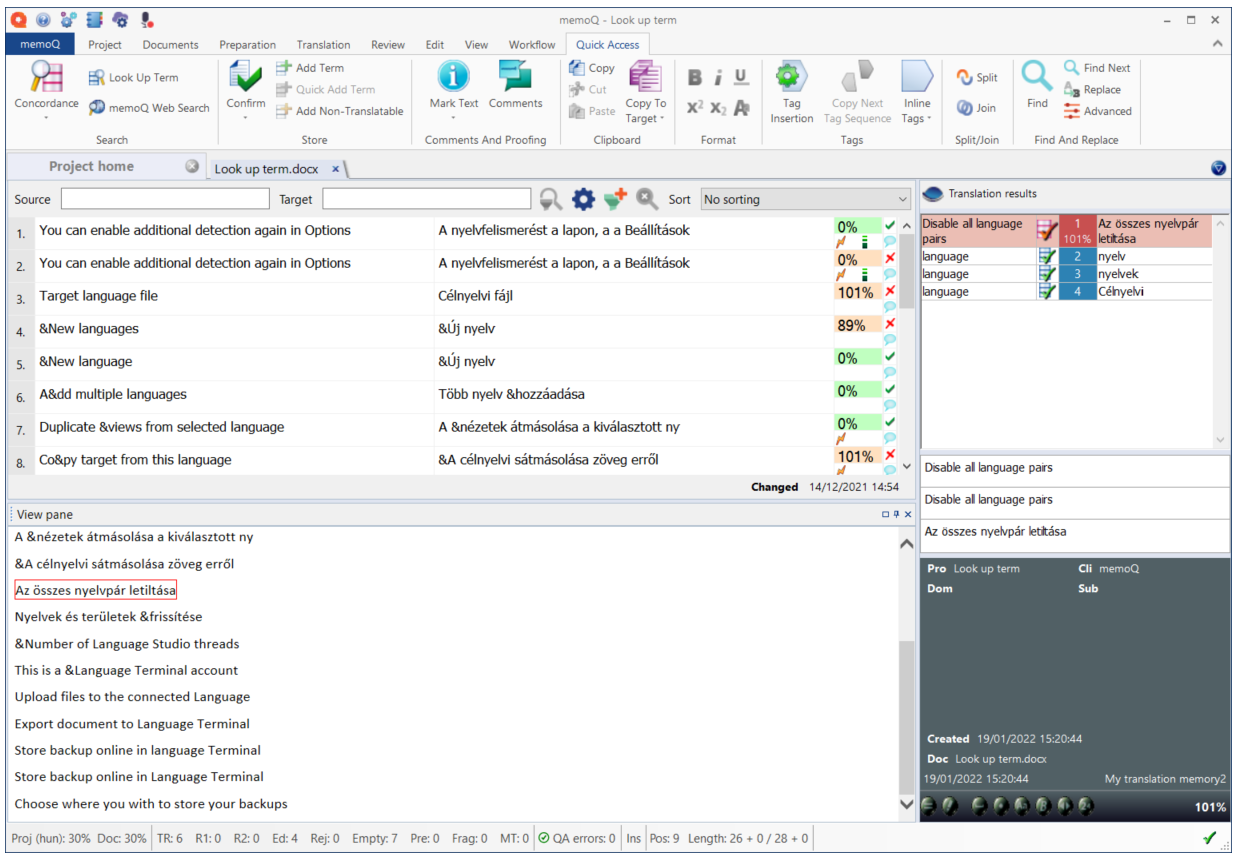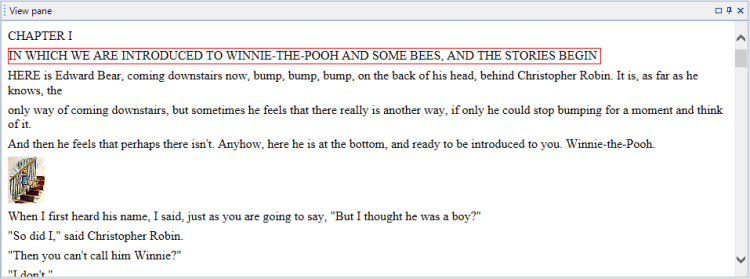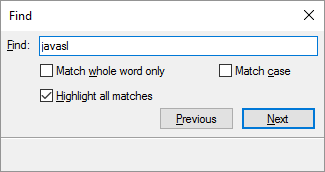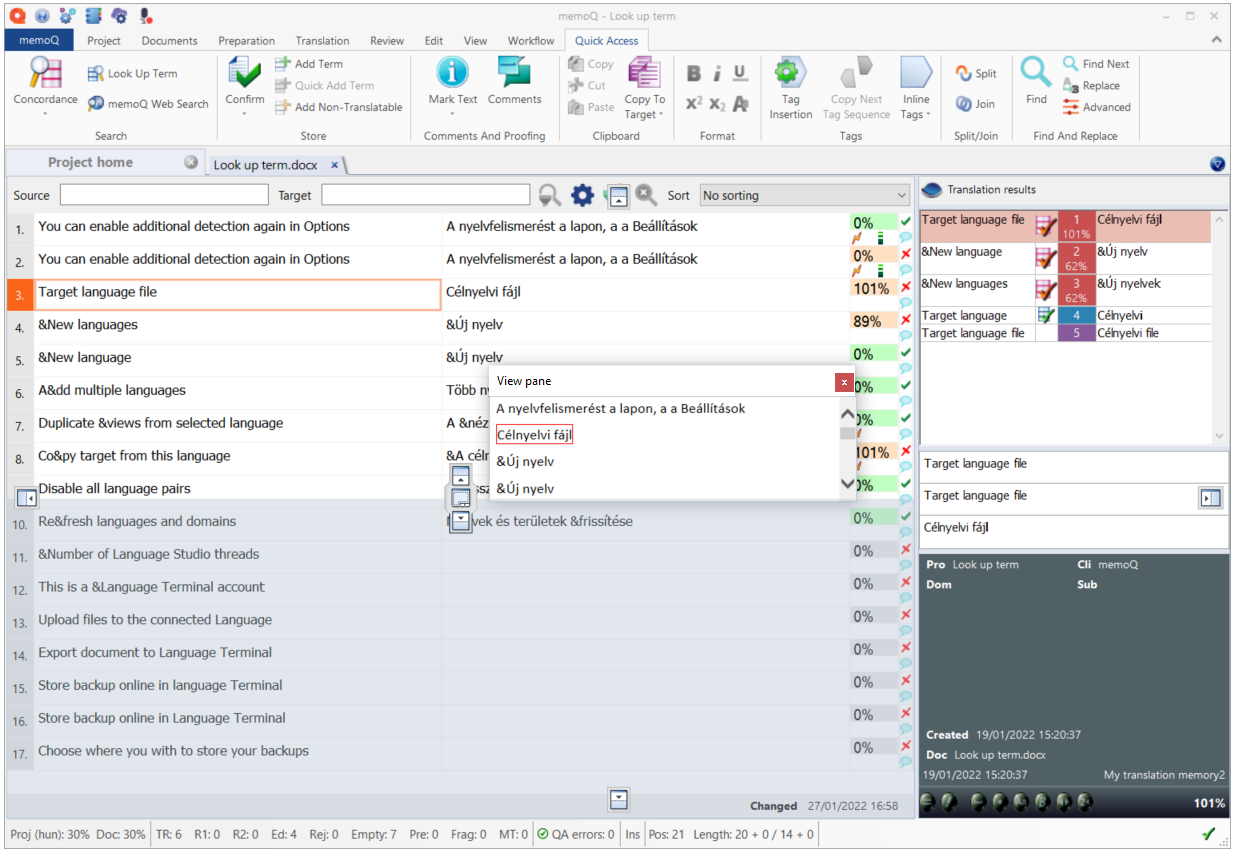Translation editor
You write or edit translations in the translation editor. Every document or view opens in a separate editor tab.
For an introduction to translating in memoQ: See the Getting Started Guide in the memoQ Help Center.
How to get here
- Open a project. This can be a local project or a checkout of an online project.
- In Project home, choose Translations.
- Find the document you need to edit. Double-click its name. The translation editor opens on a separate editor tab.
Or: Right-click the document, and choose Open For Translation.
To open a view for editing: In the Translations pane of Project home, click the Views tab. Double-click the name of the view you need to edit.
Are you getting an error when you try to open a document? Maybe your computer is missing a font that memoQ needs to show the text. When this happens, install the language pack in Windows for both your source language and your target language. To do this, open Control Panel in Windows. Choose Language, click Add language, then choose the language you need, and - at the bottom - click Add. Then, next to the language, click Options, and then click Download and install language pack. (This is what you do in Windows 10; to our knowledge, the error occurs most often in Windows 10 and with the Korean language.)

What can you do?
This happens in the Grid. It shows each segment in a separate row.
- In running text, a segment usually corresponds to a sentence.
- In structured content (tables, XML files, and databases), a segment usually corresponds to a cell or a data record. It may contain just a phrase, but it may also contain several sentences.
In each row, there is a cell on the left that contains the source segment.
Type or edit the translation in the cell on the right.

To confirm your translation, press Ctrl+Enter.
When you confirm your translation:
- memoQ will save the translation in the document and in the working translation memory of the project.
- The status of the segment will become Confirmed.
- memoQ will move to the next segment and pre-translate it. If there are matches that cover the entire segment, the target cell will already have it.
You do not have to save the document: memoQ will automatically save every change, even when a segment is not confirmed.
While you write or edit the translation, you can do many things:
- Quickly insert suggestions from resources. You get predictive typing, placeable menus, and you can also pick suggestions from the translation results list.
- Select several segments, and run various operations on them.
- Format your document, and deal with inline tags, or turn specific parts into inline tags.
- Change the segments: join or split segments, or re-segment the document.
- Filter and sort the segments.
- Copy text from the source cells to target cells. Clear translations.
- Comment segments or parts of segments.
- Change the status of segments.
- Compare text to previous versions of the document.
- Lock segments.
- Pre-translate text.
- Track changes: On the Review ribbon, click Track changes.
- Turn parts of the source text into inline tags. On the Preparation ribbon, click the Regex Tagger button.
To learn more: See Help section about the Grid.
At the bottom of the window, there is the View pane. Normally, it shows a formatted preview of the document.

When you translate a segment in the Grid, the translated text will replace the source text in the View pane, too.
In the preview, the current segment is highlighted with a red border.
You can move around in the translation by clicking in the preview: If you click somewhere else in the preview, the Grid will jump there, too.
To find text in the preview: Click anywhere in the View pane. Press Ctrl+F. In the Find box, type the words to look for. memoQ will highlight the matches, and jump to the first one. You can jump to the second, third, etc. match by clicking Next. The window stays open, so that you can jump and look for other words, too.

The preview is just similar to the original document: memoQ uses various applications to turn every document into a web page. Sometimes a web page cannot look the same as the finished document. The formatting may be similar, but never identical.
Preview works for these document formats: Microsoft Word, Excel, PowerPoint, HTML, XML (through XSLT style sheets, too), multilingual Excel, text, and XML, and - through Language Terminal - InDesign.
Preview is not guaranteed: memoQ may be unable to offer a preview for certain document formats or certain documents. To produce a preview, memoQ uses external programs and parts of the operating system. This may fail at times, even if memoQ itself is in perfect working order.
Preview may show structure, not formatting: The preview of XML documents, XML-based documents, and multilingual tables shows the structure of the document, not the formatting. This is normal.
memoQ will always automatically check the current segment for suggestions. To do that, it looks into the resources of the project.
The suggestions appear on the Translation results pane, on the right.

Suggestions come from translation memories, LiveDocs corpora, term bases, machine translation, auto-translation rules, and non-translatable lists.
- Some suggestions are combinations: For example, fragment-assembled suggestions replace known terms with their translations. Sometimes translation memory entries are also replaced in them. If there is only a little difference between a translation memory suggestion and a translatable segment (one or two words), memoQ can repair it using term bases, TMs or machine translation. This feature is called MatchPatch.
- A suggestion may offer a translation for the entire segment. These usually come from a translation memory, a LiveDocs corpus, or from machine translation.
- Other suggestions may offer translations for parts of the segment. These come from term bases, auto-translation rules, or non-translatable lists - sometimes from translation memories, LiveDocs corpora, and machine translation, too.
- Some suggestions do not offer translations: Translation memories and LiveDocs corpora may come up with longest-substring concordance suggestions which open the Concordance window. These are just hints so that you can research for the translation.
To insert a suggestion:
- Use predictive typing. memoQ will predict suggestions from term bases and auto-translation rules. (Predictive typing will also give you numbers, tags and hints from Muses, but they do not come from the Translation results pane.)
- Pick a suggestion from a menu. While you are writing the translation, press (and release) Ctrl. memoQ displays a menu with numbers, tags, and term base matches. Choose one of them to insert.
- Insert a suggestion for the entire segment: Press Ctrl+Space to insert the first (topmost) suggestion. To insert another suggestion, press Ctrl and the number of the suggestion. Or, move to the suggestion by pressing Ctrl+Down and Ctrl+Up, then press Ctrl+Enter. Or, double-click the suggestion.
To learn more: See Help section about the Translation results list.
If you need to know where you are in the translation, take a glance at the status bar, at the very bottom of the window.

It shows the following details:
-
 : Server connection status. Shows if you are currently connected to the server.
: Server connection status. Shows if you are currently connected to the server. - Proj (language): A percent of how much of the project is done (in the current target language). Normally, this is shown as a percent of the word count. To change to a percent of the segment count or the character count, right-click the number, and choose a unit from the menu.
- Doc: A percentage showing how much of the document is done.
- TR: Number of segments confirmed by a translator.
- R1: Number of segments confirmed by a Reviewer 1.
- R2: Number of segments confirmed by a Reviewer 2.
- Ed: Number of segments edited but not confirmed.
- Rej: Number of segments rejected by a reviewer.
- Empty: Number of segments that haven't been touched yet.
- Pre: Number of segments that were pre-translated but not edited yet.
- Frag: Number of segments where pre-translation inserted a fragment-assembled match.
- MT: Number of segments where pre-translation inserted a machine translation plugin's output.
- QA errors: The number of errors that came up during QA.
- Ins: Normally, memoQ is in insertion mode, not in overtype mode.
- Pos: Current position in the segment.
- Length: Length of the source segment and of the target segment in characters. Tag length appears after a plus sign.
To do this, you need to connect a second screen to your computer, and tell Windows to extend the view. To do that, press Windows+P and choose correct option from the side menu.
To put the View pane on the second screen:
- Click the title bar of the View pane. Hold down the mouse button, and start dragging.
- The View pane will detach from the memoQ window.
- You can drag it anywhere: Drag it to the second screen, and maximize it.
To dock it back to the memoQ window:
- Start dragging the View window. Drag it over the memoQ window.
- Over the memoQ window, icons appear. These show where the View pane can be docked.

- Still dragging the View pane, move the pointer to one of these icons, and release the mouse button.
- To put the View pane back to its normal place, drag it to the middle, and mouse over this icon:

You have removed View pane from memoQ window? No need to worry.
-
On the View ribbon, find the Navigation box. Click the View Pane icon
 directly. memoQ displays View pane on the bottom of the window.
directly. memoQ displays View pane on the bottom of the window.
You can rearrange the Grid, the View pane, and the Translation results pane within the screen.
memoQ comes with two preset layouts: the Default and Results on top. The latter is similar to Trados Studio. To switch to another preset layout, press F11.
To return to the normal layout (even after dragging the View pane or the Translation results pane somewhere else): On the View ribbon, click the bottom of the Layout icon. From the menu, choose Default.
When you finish
You do not have to save the document: memoQ will automatically save every change, even in segments that were not confirmed.
To return to Project home: Close the editor tab by clicking the Close  button on the tab itself. Or, press Ctrl+F4.
button on the tab itself. Or, press Ctrl+F4.